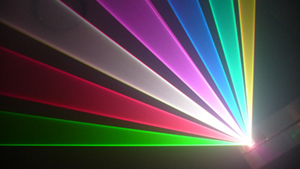
Originally Posted by
mixedgas

OK, what I have seen:
I. Bad thermal management in the laser. KTP and vandate/yag are temperature sensitive, LBO even more so. All are insulators with poor thermal conductivity, so cooling them is difficult. Non linear crystals change their phase matching angle with temperature. Really good lasers heat the KTP and cool the vandate/yag.
Laser output tends to depend on recent history in the poorer lasers.
II. Poor choice of the logic input structure on the TTL diode driver. Many of them, as so called "TTL" need enough current sunk that only 100 ohms or less to ground will start them to blank. Some have a TTL spec, some are CMOS with a pull up, some have a comparator, some wink if you couple 60 hertz in with your finger. Some have horrible hysteresis. I'm not sure about the current ILDA standard, but the input impedance in the old standard was 600 ohms. I've seen some at infinity, and I've been told about some at 50-100 ohms. I have one laser where the input device is a LED in a very slow optocoupler with 200 ohms in series. If there is one laser out there that is on at 2.4 volts or higher and off at .6 volts or lower per the TTL standard, I have yet to find it.
III Analog inputs, ditto on the impedance issues. Some lasers are biased internally so that any voltage above 0 volts adds to diode current set at just below lasing current. Some have the diode at zero current and threshold is a few volts up, cramming all the output into the last volt. Some are very good, fast, and linearized. Again, impedance is all over the place. I've seen lasers that need a analog opamp follower driving the input.
IV, There is no standard for linearity. There is no standard for threshold. There is no standard for rise and fall time. Last but NOT least there is no standard for how a laser is supposed to behave for a single blanked point in a train of illuminated points, nor a standard for how to respond to a single illuminated point in a train of blanked points.
VI, The laser tuning is often set up to favor long trains of constant illumination, being off for long periods of time results in a dim laser for a few seconds until it reaches steady state again.
Yet I have also seen lasers that are nearly perfect. The 808 nm diodes can easily follow to 150-250 Khz or more. The doubling is instant. The laser material has a long upper state storage time, and this can be a problem.
DPSS Blue is even worse then green, for a variety of other reasons. LBO in a 473 nm blue needs held to about +/- .1' C. 473 blue often has 5% low frequency noise riding on the cw beam
All of this needs hashed out to be a standard. It would somewhat help if control software/hardware had independent blanking delays for each color.
This is not new, there were complaints on early PCAOMs that they would not saturate at just 5 volts, and that they would not 100% extinguish, a leakage signal when off 30 dB down still being visible in a very dark room.
There is a dormant portion of the ILDA test pattern dealing with blanking. It is there for tuning galvo blanking, but how it was chosen is a mystery to me. There is someone I can ask, if he knows. I'll call him tomorrow.
Steve
I'll only press so far, and as I said, either you didn't pick up the specific point I was referring to, or you were avoiding it (either way might lead someone to think that way...
) - we both agree we don't quite 'get' each other's perspective - and to be clear, no bad feelings at all from me.



 Reply With Quote
Reply With Quote



